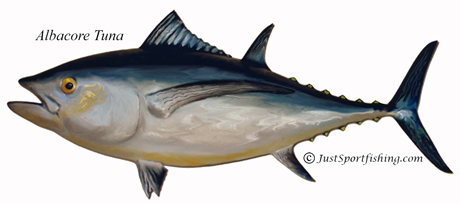|
|

How
to fish for Albacore Tuna
There are various factors to consider when choosing the saltwater lures best suited for specific albacore trolling scenarios. Gearing up for the albacore tuna hunt, offshore anglers should anticipate a full-spectrum of potential fishing conditions that may present during their trip, and be prepared to address them with an arsenal of lure choices varying in color, style, and size.
Albacore anglers need to be cognizant of the effects that ocean conditions and trolling speed will have on how a saltwater lure tracks in the water. Crankbait type plugs such as large Rapalas ® and MirrOlures ® are terrific for albacore fishing, as are the traditional cedar plugs. However effective crankbait and cedar plugs are when the seas are smooth, they are extremely difficult to keep in the water during sloppy conditions.
The best albacore trolling speeds are within a range of six (6) and eight (8) knots. Switching to larger lures can also draw additional strikes from Yellowfin Tuna, Bluefin Tuna and Bigeye Tuna, all while attempting to keep the Skipjack away (unless fishing waters similar to the Pacific Northwest).
Albacore, at times, may tend to not strike the larger lure sizes. As a rule, utilize the darker color offshore lures when trolling for albacore tuna in the gray of dawn and late evening. As the day brightens, lighter color lures become the better producers. In addition, as the sun continues to grow stronger, keep the lure deeper in the water while trolling. If the wind begins to blow and the ocean starts to get sloppy, your tuna feathers may become ineffective and spend too much time skipping across the surface, this is a good time to consider switching to a Jet Head Lure or some other heavier tuna type jig like the LOLO Lure. Other types of swimbaits can also be very productive for catching albacore tuna, especially when fishing the slide. Many of these lures can be purchased online at EatMeLures.com
When bait fishing for albacore you will most often be using anchovy or sardine for bait. Use a number 2 or 4 hook when using anchovy and a 1/0 to 3/0 hook for sardine. Hook the anchovy either through the nose or the bone behind the gill, for the sardine either the nose or on the bottom of the bait behind the vent, hooking on the bottom tends to make the bait swim deeper. If you're not getting any bites fly lining your bait try a small amount of weight, rubber core sinkers are handy for this because you can add them quickly, remember to change your bait often if the bite is light a natural swimming bait will draw bites that a weak bait won't.
Try getting a bait or jig down about 60'. The bigger fish will be on the bottom of the school and you may wind up with an bigger Albacore or bigeye tuna taking the bait.

|
JustSportfishing.com

|


